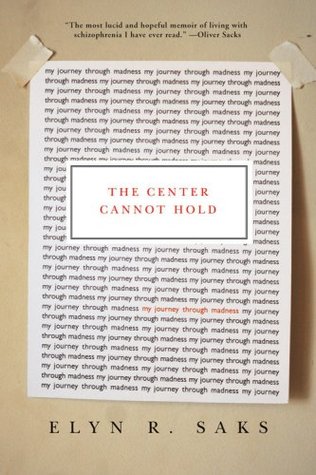More on this book
Community
Kindle Notes & Highlights
by
Elyn R. Saks
Read between
March 21 - March 27, 2024
explaining what I’ve come to call “disorganization” is a different challenge altogether. Consciousness gradually loses its coherence. One’s center gives way. The center cannot hold. The “me” becomes a haze, and the solid center from which one experiences reality breaks up like a bad radio signal.
In fact, it is not necessarily true that everything can be conquered with willpower. There are forces of nature and circumstance that are beyond our control, let alone our understanding, and to insist on victory in the face of this, to accept nothing less, is just asking for a soul-pummeling. The simple truth is, not every fight can be won.
Schizophrenia rolls in like a slow fog, becoming imperceptibly thicker as time goes on. At first, the day is bright enough, the sky is clear, the sunlight warms your shoulders. But soon, you notice a haze beginning to gather around you, and the air feels not quite so warm. After a while, the sun is a dim lightbulb behind a heavy cloth. The horizon has vanished into a gray mist, and you feel a thick dampness in your lungs as you stand, cold and wet, in the afternoon dark.
When you’re really crazy, respect is like a lifeline someone’s throwing you. Catch this and maybe you won’t drown.
this was talk therapy of the densest, most intellectually rigorous, challenging, and unsettling sort: Kleinian analysis, a treatment method that found its origins in the work of Sigmund Freud. Freud built his theory of mind and method of treatment upon the concept of the human “unconscious”—the idea that we all think, feel, and do what we do for reasons that we are not entirely aware of. He believed that the unconscious was a “seething cauldron,” filled with primitive forces at war with one another, forces that literally drove us to act. Central to Freud’s thinking about psychoanalysis was the
...more
Freud had many reservations, however, about what could be accomplished with a psychotic analysand. He believed that psychosis was too narcissistic, too inward-looking, to allow the patient to develop a transference relationship with the analyst, and without that transference, there would be no grist for the psychoanalytic mill.
Elizabeth Jones, however, was a “Kleinian”—she practiced an offshoot of Freudian analysis developed by Melanie Klein, an Austrian psychoanalyst who immigrated to London in the late 1920s. Unlike Freud (and later, his daughter Anna), Klein believed that people with psychosis could benefit from analysis and that the necessary transference would develop. It was her theory that psychotic individuals are filled with (even driven by) great anxiety, and that the way to provide relief is to focus directly on the deepest sources of that anxiety.
A central tenet of both classical and Kleinian analysis is that the treater must remain fairly anonymous to her patient—she does not answer questions about herself, have pictures of her family on the wall, tell you where she went to school or where she is going on vacation. Indeed, you don’t even see your analyst during your sessions—how she looks as she reacts to you and what you are saying. You’re on the couch. There is a simple reason for this: If the analyst is a so-called blank slate, the traits the patient attributes to her come primarily from the patient rather than the analyst. That’s
...more
Schizophrenia is a brain disease which entails a profound loss of connection to reality. It is often accompanied with delusions, which are fixed yet false beliefs—such as you have killed thousands of people—and hallucinations, which are false sensory perceptions—
Intelligence, combined with discipline, could overcome any challenge.
He smiled. I laughed. He got it. I knew this man, whose depth of heart was equal to the speed of his mind, would be a lifelong friend.
The DSM makes a rough distinction between disorders of thought and disorders of mood. Schizophrenia is an example of a disorder that affects thinking, and so it is referred to as a thought disorder. Bipolar disorder (what used to be called manic depression) is an example of a mood or “affective” disorder—a disorder that rests primarily in how one feels. The DSM places schizophrenia among the thought disorders characterized by psychosis. Psychosis is broadly defined as being out of touch with reality—


